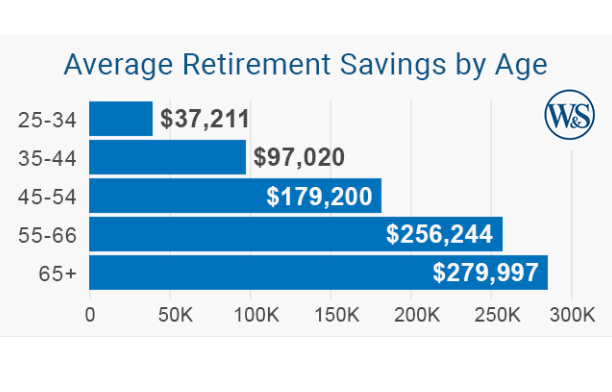There isn't a one-size-fits-all method to build wealth that would sustain us through retirement and beyond. And while the answer to our question may vary depending on individual circumstances and lifestyle preferences, understanding the factors that contribute to a secure and fulfilling retirement is essential. For some basic guiding principles on building wealth, check out this blog.
In this blog post, we will explore the key considerations that define a good monthly retirement income, delving into factors such as financial stability, healthcare expenses, leisure activities, and the pursuit of lifelong dreams. By shedding light on these aspects, we aim to provide insights and guidance to help you determine the ideal monthly income that can sustain your desired retirement lifestyle and bring peace of mind in your golden years.
Key Takeaways
- Average retirement savings in the US show varying balances across different age groups, with factors like 401(k) account balances and defined contribution retirement plans influencing the figures.
- The desired retirement income will depend on individual circumstances, such as retirement expenses, lifestyle preferences, health, and personal goals. Different methods, including the "50-30-20" rule of thumb, can help estimate the required income.
- Experts suggest aiming for approximately 80% of pre-retirement income as a suitable monthly retirement income goal. However, individual needs and preferences may vary, and financial advisors can provide personalized guidance.
Disclaimer
The contents of this article are for educational purposes only. They are not intended to be a source of professional financial advice. You will find experts on financial planning and financial management here. More on disclaimers here.
Retirement planning advisors
Just like pilots require training for every flight, achieving top financial performance also necessitates guidance and expertise. Going it alone is seldom the optimal approach. When it comes to planning your retirement income, it's crucial to involve a financial professional right from the start. Our certified financial planner and financial advisor are here to provide the support you require. Initiate a conversation today and obtain the guidance you need.
What is retirement income?

After years of extensive data analysis and interactions with individuals, it is quite probable that contemplating post-retirement funds as income may not be appealing to you, primarily due to the tax implications associated with traditional income. However, it is prudent to adopt a perspective that aligns with government regulations before personalizing your approach and reacting.
It is essential to understand that the legal definition of retirement income encompasses various sources, including social security benefits, annuities, retirement or profit sharing plans, insurance contracts, IRAs, and more. Importantly, it's worth noting that these sources of income may be subject to full or partial taxation, especially if funded with pre-tax income.
And a good retirement income has to cater for healthcare expenses, leisure activities, and the pursuit of lifelong dreams while addressing the tax element. However, we need to put some number on the answer to the question. Let's see some stats to provide context.
Average retirement savings in the US

Since IRA savings and investment accounts are the primary retirement income sources for most of the US, let's begin with a look over US retirement savings.
Vanguard, a renowned investment firm, conducted an extensive analysis of approximately 5 million retirement accounts for its comprehensive report titled "How America Saves." Based on the latest findings, the average balance in a 401(k) account reached $141,542 in 2021, marking a notable increase of approximately 10% compared to the previous year.
On the other hand, Alight's 2023 Universe Benchmarks Report revealed that the average balance in defined contribution retirement plans experienced a decline. The report indicates that by the end of 2022, the average balance had dropped to $111,210 from an initial amount of $144,280 at the beginning of the year.
Average retirement savings by age

The table below shows the average retirement savings balance for the US population by age:
| Age | Average Retirement Account Balance |
|---|---|
| 35-44 | $131,950 |
| 45-54 | $254,720 |
| 55-64 | $408,420 |
| 65-74 | $426,070 |
Depending on the state of a retiree, experts often suggest a percentage of pre-retirement income as an ideal retirement income. As a result, it is important that we can compare these statistics with the general US savings.
Average monthly retirement income in the US

The 2022 CPS ASEC survey collected data on household income for the year 2021, providing insights into the average retirement income for individuals aged 65 and older in the United States. The data reveals that the average retirement income for this age group is $75,254. However, when considering the median income, which represents the midpoint value, the figure drops to $47,620.
Further analysis from the Bureau of Labor Statistics (BLS) indicates the average incomes after taxes for older households in 2021. For individuals aged 65 to 74 years, the average annual income was $59,872, equivalent to $4,989 per month. In comparison, those aged 75 and older had an average annual income of $43,217, translating to $3,601 per month.
Which state has the lowest average retirement income?
Among the states, Indiana stands out with the lowest average income for retirees, amounting to $20,521 annually or $1,710 per month. Combining this with the median retirement income, it becomes evident that a great percentage of retirees have far less than they require for their golden years and many of them may have to look to the social security administration.
How much retirement income will you need?

The amount of income needed for retirement can vary depending on retirement expenses in individual circumstances. Factors such as age, health, lifestyle preferences, and personal goals all play a role in determining your specific needs. For instance, younger and healthier individuals may require less income compared to older individuals facing health issues. Likewise, those with an active lifestyle and a passion for travel may necessitate multiple income streams compared to those who are content with a more home-centered lifestyle.
Numerous methods can help estimate the required retirement income. One popular approach is the "50-30-20" rule of thumb. This rule suggests allocating 50% of your income for essential expenses, 30% for non-essential or discretionary expenses, and 20% for savings. While this guideline can serve as a useful starting point, it's important to recognize that it's a general rule, and your actual needs may deviate from it based on your unique circumstances.
Ultimately, it is crucial to assess your own situation, taking into account your specific financial obligations, desired lifestyle, and long-term goals when determining the appropriate amount of income needed for a comfortable and fulfilling retirement.
What is a good retirement income?

Given the significance of having sufficient funds during retirement, it's understandable that many individuals are eager to maximize their monthly retirement income. This goal reflects the desire to ensure financial stability and maintain a comfortable lifestyle throughout the retirement years.
However, it's important to note that the account balance in retirement savings doesn't directly translate to a reliable income source. In fact, a significant portion of retirees would exhaust their funds within a mere five years if they solely relied on their savings.
Numerous experts in the field emphasize that a suitable retirement income should aim to cover approximately 80% of a couple's final pre-retirement annual earnings. For instance, Fidelity Investments suggests that individuals should strive to save an amount equal to ten times their annual income by the age of 67 as a target for a secure retirement. This approach provides a guideline for building a robust financial foundation that can sustain a comfortable lifestyle during the retirement years.
What's a good monthly retirement income?
!
To ensure a comfortable retirement, a widely recommended guideline is to target approximately 80% of your pre-retirement income as a monthly retirement income goal. Financial advisors often provide a range between 70% and a more cautious 90% to accommodate diverse individual circumstances and preferences.
This rule implies that aiming for 80% of your pre-retirement income is a prudent estimate to sustain your desired standard of living during retirement. While this approach is more conservative than the 50-30-20 rule, it serves as a reliable starting point since you can only have estimates of how much income you will need for your full retirement age.
Living in Indiana as a window into retirement life

When it comes to the cost of living in Indiana, the state is generally known for its affordability, although there are variations across different regions. Typically, rural areas and small towns tend to have a lower cost of living compared to larger cities. The two major cities in Indiana are Fort Wayne in the northeast and Indianapolis in the central part of the state.
In Fort Wayne, the median price for a home stands at $124,900, while in Indianapolis, it is slightly higher at $154,900. These figures are significantly below the national average of $186,000. Indiana consistently ranks as one of the most affordable states to live in, earning the sixth position in recent years for overall affordability among all states.
While average salaries in Indiana may be lower than the national average across various occupations, the exceptionally low cost of living compensates for this in most cases. Consequently, Indiana is widely regarded as one of the top states in the country in terms of overall affordability and cost of living expenses.
A final word!
Use the 4% withdrawal rule. The 4% withdrawal rule is a widely recognized strategy for retirement planning. It suggests that retirees can withdraw approximately 4% of their initial retirement portfolio balance annually, adjusted for inflation, to sustain their income throughout retirement.
It serves as a helpful guideline, but individual circumstances and market conditions should be considered when implementing this rule. Consulting with a financial advisor can provide personalized guidance for an effective retirement withdrawal strategy.
Bay Street Capital Holdings

Bay Street Capital Holdings, based in Palo Alto, is a reputable wealth management firm specializing in financial planning, investment advisory, and risk management. What sets them apart is their focus on effectively managing overall risk and volatility, rather than solely maximizing returns.
Under the leadership of esteemed founder William Huston, recognized as one of Investopedia's Top 100 Financial Advisors for 2021, Bay Street stands out as one of the two Black-owned firms among the nineteen recognized in California. Their partnership with Resthaven Properties in real estate has earned them a finalist position in the Asset Managers: Diversity, Equity, and Inclusion category at the 2023 WealthManagement.com Industry Awards.
Bay Street's commitment to diversity and support for emerging fund managers and entrepreneurs is evident through their selection as a finalist in the Corporate Social Responsibility (CSR) category for the Asset Manager in 2021. This recognition followed a competitive process involving over 900 nationwide firms, demonstrating their dedication to making a positive social impact.
Sources
https://apps.irs.gov/app/vita/content/globalmedia/teacher/11_retincome_lesplan.pdf
https://money.usnews.com/money/retirement/articles/average-retirement-savings-balance-by-age
https://www.annuityexpertadvice.com/good-monthly-retirement-income/





















